Building India’s AI infrastructure: data centers, edge build-outs and a 5G backbone
India’s push to become a global AI hub is reshaping the country’s digital plumbing—from hyperscale data-center campuses to edge facilities in smaller cities and an aggressive 5G rollout. The Union Cabinet’s approval in March 2024 of the IndiaAI Mission, with budgeted outlay of more than ₹10,300 crore, set a public-policy anchor for compute, datasets and skills.
On the private side, investment commitments have accelerated. Microsoft has announced a US$3 billion, two-year expansion of cloud and AI infrastructure in India, alongside sector partnerships in manufacturing, financial services and healthcare. Google is preparing its first India hyperscale campus in Visakhapatnam, with reports suggesting a spend of about US$6 billion on a one-gigawatt site, including significant investment in renewables. Domestic operators are scaling rapidly as well. Hyderabad-based CtrlS has unveiled plans for a 600 MW data-center park near the city, part of a broader shift to Tier IV designs and liquid-cooling for AI workloads.
Sizing the market is tricky, but multiple trackers point to a sharp upturn. Industry analyses value the sector at around US$10 billion in FY2023/24, with capacity growth of nearly 140% since 2019. Colliers estimates about US$15 billion has flowed into Indian data centers since 2020, with another US$20–25 billion expected by 2030. International organisations highlight infrastructure, data and skills as the core levers for inclusive AI—consistent with India’s current build-out.
Much of the new capacity is no longer metro-only. Edge data centers are spreading to Tier-2 and Tier-3 locations from Kochi and Indore to Patna and Mohali to reduce latency for AI-enabled services and smart-city projects. Though still a small base—about 82 MW, or 6% of national capacity—analysts expect secondary markets to reach 300–400 MW by 2030 as fiber densifies and regional demand rises.
Connectivity is the other pillar. Since 5G launched in October 2022, India has installed roughly 469,000 base transceiver stations as of early 2025, with services available in nearly every district—a rollout pace the government describes as among the world’s fastest. Independent research, however, still flags uneven fiber backhaul and pockets of high latency, particularly outside major corridors, underscoring the need for continued investment to unlock low-latency AI use cases at scale.
Affordability remains a comparative advantage. India is regularly ranked among the world’s cheapest markets for mobile data, a factor that expands the addressable user base for AI-enabled services, even if absolute rankings vary slightly by year and source.
India is also working the ecosystem side. As lead chair of the Global Partnership on AI in 2024 and host of the 2023 ministerial in New Delhi, it pushed governance and safety agendas while courting research collaborations. At the institute level, initiatives such as INAI—an applied-AI center anchored at IIIT-Hyderabad and championed by Intel and the Government of Telangana—and Intel’s Unnati labs illustrate how corporates and universities are seeding talent and applied research capacity that can plug directly into industry.
The article’s original claims broadly align with current developments but required adjustments. Google’s Visakhapatnam spend is based on industry reporting rather than a formal company announcement; Microsoft’s US$3 billion India program is confirmed. The figure that India’s data-center market is “US$10 billion” appears in secondary industry analysis, with Colliers’ investment tallies providing another reference point. References to “H data centres” are more accurately described as “edge data centers.” 5G deployment totals were updated to the government’s latest published count of 469,000 base stations.
Bottom line: India’s AI infrastructure story is no longer hypothetical. Hyperscale campuses are being financed, edge sites are spreading to secondary cities, and 5G coverage is approaching nationwide—with continuing gaps in fiber that need closing. If the current mix of public outlay, private capital and university–industry programs holds, India’s AI stack will keep moving from flagship announcements to real, distributed capacity over the next two to five years.
© 2025 www.cijeurope.com









